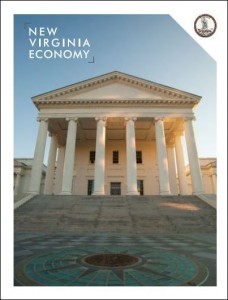Last week Governor Terry McAuliffe published his strategic plan for economic development, which will provide a road map for legislative and executive policy for the remainder of his term. My quick-and-dirty analysis is that there’s nothing much new here — it checks all the usual boxes — but there’s nothing offensive either. This strategic plan, like those of previous administrations, represents the conventional wisdom of the usual stakeholders.
While the plan does acknowledge the necessity of emancipating Virginia’s economy from his dependence upon the federal government, it ignores the state’s slipping rating in a variety of national business climate rankings. Indeed, the report engages in delusional thinking. “From the robust economy to competitive taxes and incentives, Virginia’s pro-business climate has few, if any, peers,” states a passage describing Virginia’s economic development assets. I think Virginia is a great state and wouldn’t live anywhere else but, really, I know nonsense when I see it. Few peers? C’mon.
Virginia does have many strengths, which served the state well in a previous economic era dominated by corporate recruitment. Our building costs are eight to 22 percent lower than the national average. We have the second lowest workers’ compensation costs in the country. The state has maintained a AAA bond rating since 1938. Virginia can boast of “the greatest number of scientists and engineers of any state.” But the state is struggling to shift to an entrepreneurial, knowledge-based economy.
At least the authors of the report understand that such a transition must be made. As they note, thirteen of the state’s top 20 employers are either public-sector enterprises (U.S. Department of Defense, Fairfax County Public Schools) or private contractors dependent upon federal spending (Huntington Ingalls Industries, owner of the Newport News shipbuilding complex). But the situation is even worse than that. Of the top private sector employers, three are retailers (Walmart, Food Lion and Lowe’s Home Centers) and two (Sentara Healthcare and HCA Virginia Health System) are medical enterprises, none of which provide goods or services tradable outside the state. Only one company — Capital One Bank — creates products and services that it trades outside Virginia. That’s a sad commentary indeed.
The report correctly contends that the focus of economic development should be on building private companies that aren’t dependent upon government spending. To foster that growth, it sees government playing supporting role by being best in class in five areas: infrastructure; strategic growth sectors; overall business climate; entrepreneurism and innovation; and talent. The report also is realistic enough to know that in the current economically constrained environment, the commonwealth of Virginia is in no position to launch any big spending initiatives. The proposals described in the report are appropriately modest and focused.
The biggest void in the report is the lack of any connection between economic development and community development. Arguably, the biggest single challenge in economic development is not just developing a skilled and educated workforce but recruiting and retaining a workforce. It’s the old Richard Florida creative-class thesis. Corporations locate where the skilled labor is. Workers with education and skills tend to pick where they live, based on lifestyle amenities and cultural attitudes, not on where they can find a job. If a company can’t recruit workers to live in [name of your town here], it will suffer a competitive disadvantage. If young, skilled employees decamp for other metropolitan regions, the labor pool shrinks… and employers suffer a competitive advantage.
Our understanding of what mobile but highly desirable creative-class employees are looking for in their lives is still fairly primitive. We have some vague ideas — educated young people like walkable urbanism, bicycle lanes, cool food, a live music scene, etc. etc. — but no one is factoring that knowledge into a clearly articulated strategy that encompasses zoning policies, transportation improvements and public works investments. Until we do, every governor’s economic-development strategic plan will fall short.



